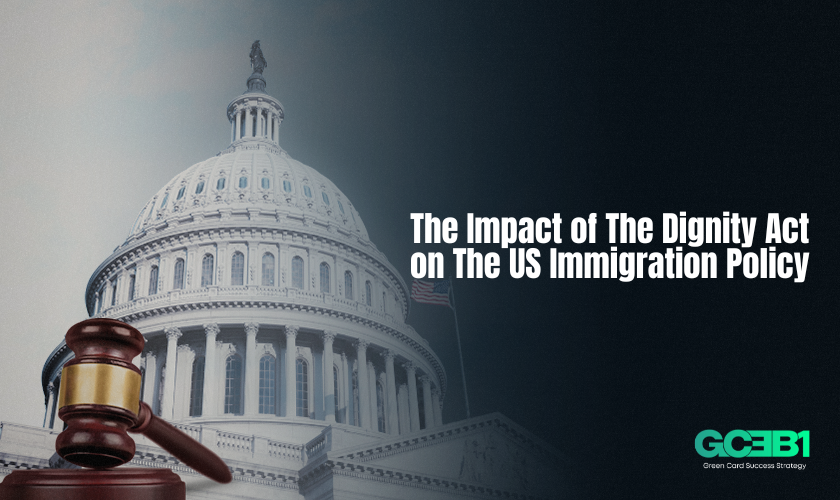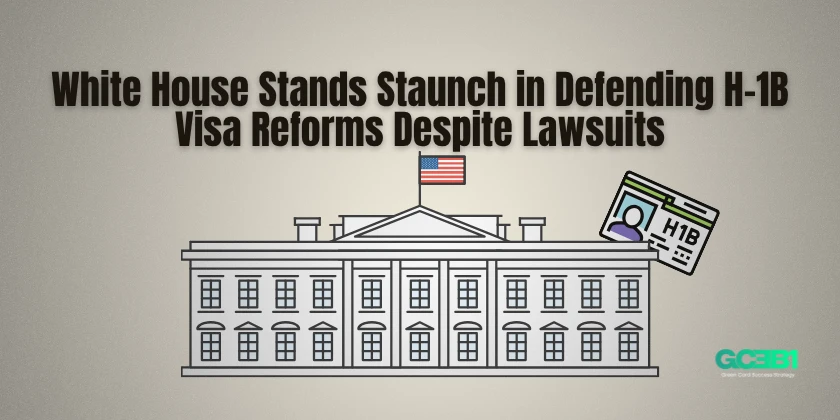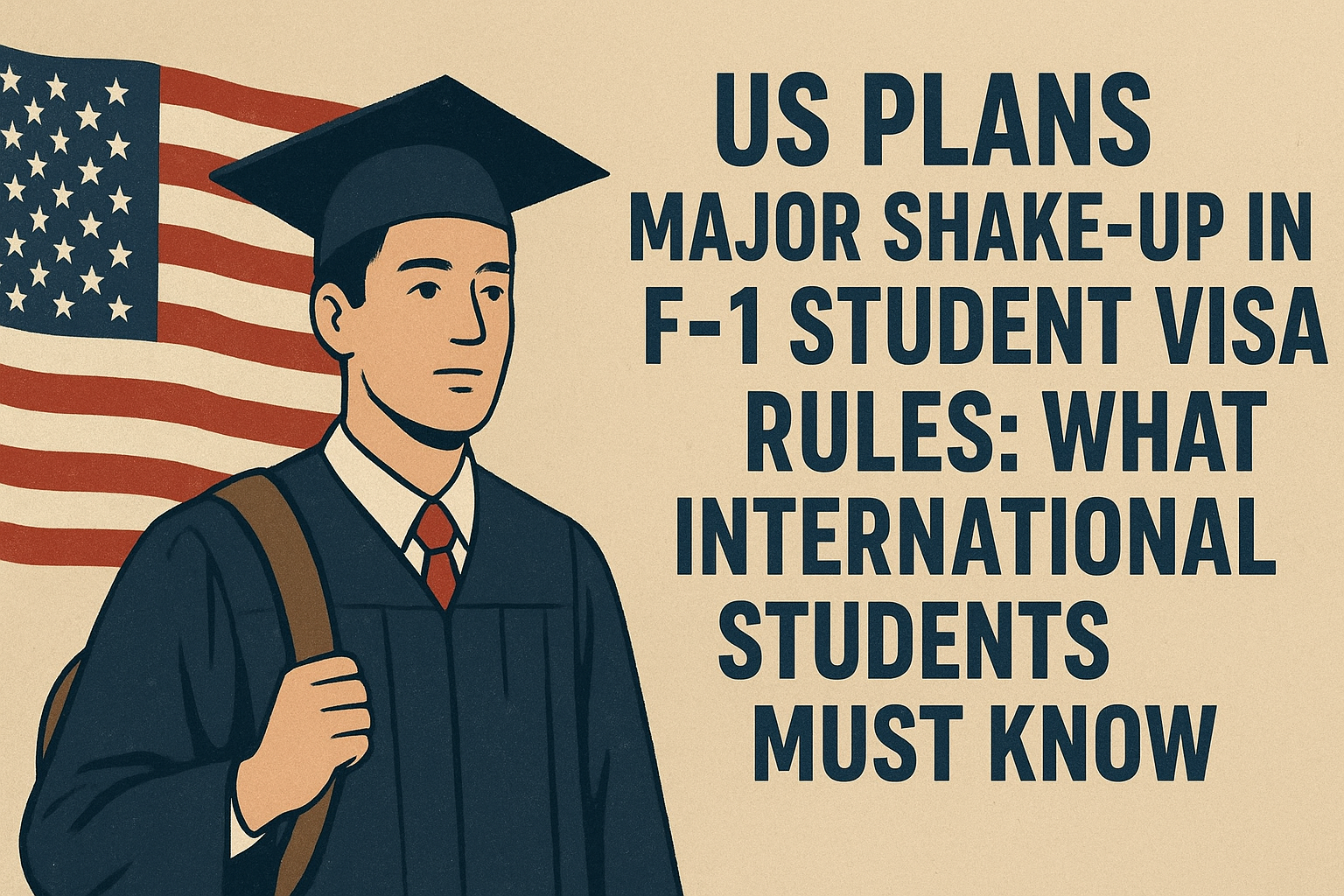The Impact of The Dignity Act on The US Immigration Policy

The Dignity Act of 2025 was introduced in the U.S. House of Representatives on July 15, 2025. It was part of a bipartisan effort to strengthen border security in the United States while providing undocumented individuals with an opportunity to obtain legal status under certain conditions. This bill also updates certain aspects of the U.S. legal immigration system
The bill gets a co-sponsoring nod from Representative Veronica Escobar and an additional 10 original Republican co-sponsors. It is a scrutinised and revised version of the Dignity Act of 2023. The bill’s entire title is ‘Dignity for Immigrants While Guarding Our Nation to Ignite and Deliver the American Dream’. Here, we take a closer look at how this bill changes the entire landscape of immigration and the green card in America.
The three core elements of the Dignity Act bill
The bill is divided into the following three sections:
Division A: A tougher & faster approach to border security
Division A of the immigration reform bill, “Border Security for America Act”, focuses on building a stronger, more controlled border while tightening the asylum process and employment verification systems. Designed to address long-standing security and processing challenges, it brings a mix of high-tech solutions, faster asylum rulings, and tougher legal consequences. Here's what it all means in simple terms.
Upgrading border security with barriers and tech
The bill gives the Department of Homeland Security (DHS) the authority to deploy physical barriers, surveillance technology, and tactical infrastructure where it’s most needed. This means more walls, levees, roads, lights, and detection tools across key sections of the border.
To fast-track this effort, DHS can bypass legal red tape when building. Backed by $46.5 billion in approved funds, the plan also allocates another $10 billion to expand and modernize ports of entry through 2030.
To support this, Border Patrol agents’ pay will get a significant 14% boost.
Faster and streamlined asylum process
The bill sets strict timelines for asylum cases at the border; most cases must be resolved within 60 days.
To make that happen, the government will:
- Create three new “Humanitarian Campuses” at the southern border to house asylum seekers,
- Hire at least 300 new asylum officers, and
- Conduct health checks, biometric scans, and criminal background checks within the first 15 days of arrival.
After that, two officers will review each asylum claim. If there’s disagreement or the case is complex, it goes to an immigration judge. If the claim is denied, expedited removal is triggered.
Additionally, in-country screening centers will be established in Latin America for family reunification, pre-screened asylum cases, and work-related visa education. A new humanitarian visa would be created with an annual cap matching the refugee ceiling.
Protections for unaccompanied minors
The bill mandates:
- Background checks for all sponsors and adult household members,
- Bans placements with individuals charged or convicted of serious crimes, and
- Imposes stricter penalties for fraud tied to child custody transfers.
Two-strike policy for border crossers
Migrants caught crossing illegally will be logged and told to apply at a legal port of entry. A second illegal crossing attempt would result in immediate removal.
Mandatory E-Verify for all employers
To stop unauthorized employment, the bill enforces a mandatory employment verification system (E-Verify) for all new hires. Companies must confirm a worker’s eligibility or face increased civil fines and penalties.
Implementation will be phased:
- Large companies (10,000+ employees): 6 months
- Medium (500–10,000): 12 months
- Small businesses (1–20): 24 months
- Agricultural employers: up to 30 months
- Very small employers (50 or fewer): may request a 6-month extension
Criminal Penalties: getting tougher
- Illegal reentry could now lead to 10 years in prison, or up to 20 years for repeat offenders.
- Voting illegally by non-citizens carries up to 5 years in prison.
- DNA testing may be used to verify family relationships among migrants.
- New penalties target child sex trafficking, aiding undocumented entry, and “spotting” (helping people evade border patrol).
Funding immigration infrastructure
To help fund these programs, the bill introduces a 1% income fee for individuals working under the Dignity Program (outlined in Division B). That money goes into the Immigration Infrastructure & Debt Reduction Fund, expected to generate $50 billion, which would result in a net surplus for the U.S. Treasury.
Division A focuses heavily on border security, enforcing immigration laws, and speeding up the asylum system without compromising oversight. It combines physical infrastructure, tech, and strict timelines to reduce long delays and illegal crossings.
While the changes are tough, the bill also introduces many humanitarian considerations. These include legal processing hubs, better protections for minors, and a clearer structure for both employers and asylum seekers. It is a bold attempt to bring order, speed, and structure to one of the most complex areas of U.S. policy.
Division B: Dignity & American Promise
A major part of the new immigration reform bill is Division B: Dignity & American Promise. It focuses on giving long-time undocumented immigrants, including Dreamers and DACA recipients, a structured, lawful way to remain in the United States. Here is what this section is really about, explained in a clear and concise way.
Protecting dreamers with a path to citizenship
At the heart of this bill is a version of the Dream Act, which could offer protection to nearly 2.5 million Dreamers, including current DACA recipients. These are individuals brought to the U.S. as children, many of whom have grown up knowing no other country as home.
Dreamers who meet the criteria can apply for Conditional Permanent Residency, a status that allows them to live, work, and travel legally for up to 10 years. To qualify, they must have entered the U.S. at age 18 or younger, been here since before January 1, 2021, passed a background check, and met certain education requirements.
Eventually, eligible Dreamers can remove the “conditional” tag and become Lawful Permanent Residents (Green Card holders) if they:
- Earn a college or vocational degree,
- Serve 3+ years in the U.S. military, or
- Work for at least 4 years with a valid permit.
This pathway ultimately leads to U.S. citizenship, offering these young Americans-in-all-but-name a permanent place in the country they call home.
Introducing the dignity program: legal status without citizenship
The bill also introduces the dignity program, a unique approach for the estimated 10.5 million undocumented immigrants who have lived in the U.S. for many years. While this path does not lead to citizenship, it offers renewable legal status for those who meet certain conditions.
To join the seven-year Dignity Program, applicants must:
- Have lived in the U.S. since December 31, 2020
- Pass a criminal background check,
- Pay $7,000 in fines over seven years,
- Pay back any owed taxes,
- Get health coverage, and
- Stay employed or enrolled in school for at least 4 of the 7 years.
Participants can not use federal assistance programs. After completing the program, they can apply for Dignity Status, a renewable 7-year legal status that allows them to live and work in the U.S. as long as they remain in good standing.
Those who don’t qualify or apply within 12 months would be required to leave the U.S.
Investing in American workers
To support U.S. citizens, the bill creates the American Worker Fund, financed by the fines paid through the Dignity Program. This fund provides grants to help Americans upskill or transition into new careers, especially through apprenticeships, job training, and high-demand educational programs. For every immigrant who participates in the Dignity Program, the goal is to upskill at least one American worker.
Division B of this bill balances compassion and accountability. It offers Dreamers a path to citizenship and gives long-time undocumented immigrants a way to live legally in the U.S., contribute to society, and remain part of the communities they’ve helped build. This bill also reinforces a strong support system for American workers.
Whether you are an employer, immigrant, or just curious about immigration reform, this part of the bill aims to shape a fairer and more functional immigration future for everyone.
Division C: A clearer & fairer path for legal immigration and family unity
This division of the immigration reform bill brings some important, thoughtful updates to the U.S. legal immigration system. It puts important emphasis on keeping the families together and fixing outdated visa backlogs. It also expands opportunities for skilled workers and students. This section aims to make the entire immigration process more compassionate and productive. Here is a breakdown of all its elements.
Stronger support for family unity
The bill incorporates key ideas from the American Families United Act, recognizing that separating families causes real hardship. In cases where a spouse or child of a U.S. citizen lacks lawful status, DHS can now choose to:
- Waive certain deportation or inadmissibility grounds,
- Hold off on removal orders, or
- Allow re-application for admission, all on a case-by-case basis.
It also introduces a 90-day “Family Purposes” visa, allowing close relatives to visit the U.S. for major life events, like weddings, funerals, or reunions. For immigrants serving in the military, the naturalization process will become more streamlined and consistent.
Fairness for legal immigrants: tackling the backlog
Visa backlogs have trapped millions in limbo. This bill sets a goal to eliminate the 10+ year waitlists by 2035. Those stuck in the system for over a decade can pay a $20,000 premium to expedite their visa.
It also raises the green card per-country cap from 7% to 15%. This would help applicants from highly backlogged countries, like India or China, move forward more quickly.
Protection for documented dreamers
Children of long-term work visa holders, often known as Documented Dreamers, face the risk of aging out of legal status at age 21. This bill prevents that. If they’ve been lawfully present for at least 10 cumulative years, they can apply for green card status and stay in the U.S. permanently.
Boosting employment and student visas
Several forward-thinking changes are proposed for work-based and student visa holders:
- Family members (spouses & children) won’t count against visa quotas. This will free up more spots for employment-based visa applicants.
- F-1 student visas will now be dual intent, meaning students no longer need to prove they will return home after graduation. This makes the U.S. more attractive to global talent.
- Students in the OPT (Optional Practical Training) program will now contribute to Social Security and Medicare, like other U.S. workers.
- PhDs in STEM and medical fields will be presumed eligible for O-Visas, which are reserved for individuals with extraordinary ability.
The bill creates a new Immigration Agency Coordinator. This office will oversee USCIS, the State Department, and the Department of Labor. In essence, the bill will drive more employment-based visa opportunities and reduce the backlogs. The bill sets aside $3.6 billion for this modernization effort.
What These Immigration Policies Mean for Employment-Based Visas
For employment-based visa categories like EB-1A green card, which is designed for individuals with extraordinary ability in fields such as science, arts, education, business, or athletics, the proposed reforms signal a more efficient and fair immigration landscape. One of the most significant changes is the exclusion of spouses and children from annual visa caps, which could free up thousands of spots each year for high-skilled professionals. Additionally, raising the per-country visa cap from 7% to 15% will ease long-standing backlogs for applicants from highly populated countries like India and China.
These updates are especially beneficial for EB-1A applicants, who are often caught in procedural delays despite being top-tier talents.
Looking to know more about where your particular case stands? Wondering whether you are EB-1A ready? Take your free assessment here.
For more personalised and tailored suggestions from GCEB1, reach out to us today!





.webp)
.webp)

.png)


.png)

.png)
